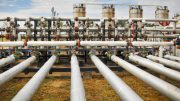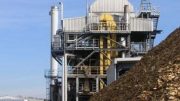Air pollution from burning fossil fuels causes over 50,000 U.S. deaths and $445 billion in economic damage annually.
The United States can achieve net-zero carbon emissions by 2050 while creating half a million new jobs, modernizing the energy infrastructure, and avoiding hundreds of thousands of needless deaths, according to the comprehensive Net Zero America study by researchers at Princeton University. The study concluded that the price tag for a major energy transition would be no more than the current system costs.
But the results of the Net Zero study are even better than they appear at first glance, because the transition to renewable energy can partly pay for itself, simply because replacing fossil fuels would mean fewer people die from air pollution.
Though the primary motivator in adopting clean energy is to reduce climate-warming greenhouse gas emissions, cleaner air is an enormous co-benefit. Phasing out coal, natural gas, and internal combustion engines has immediate, local, and concrete effects on air quality and human lives.
A recent study found that air pollution from fossil fuels kills 8 million people per year, worldwide. In the U.S. alone, a 2019 study estimated that fossil fuel use causes over 50,000 deaths and $445 billion in economic damage annually. (See also: Burning fossil fuels heats the climate. It also harms public health)
The economic and health burdens of air pollution are borne by individuals, families, and society, not by energy companies. The damage is socially and racially unjust, levying the heaviest toll on those least responsible for causing the problem. The fossil fuel industry’s ability to freely pollute and cause widespread degradation to public health is an example of a generous subsidy, because society bears the costs for oil, gas, and coal’s business model.
Fewer respirators, more solar panels
The Net Zero America report explores how decarbonizing the energy supply would affect jobs, public health, agriculture, and scores of other factors. The report was originally published in December 2020, and an updated, refined version of the study is soon to be released.
Erin Mayfield, a co-author of the study and an associate research scholar at Princeton who studies societal impacts of environmental policy, shared some of the new datasets with YCC. The numbers point to huge benefits of switching to clean energy, in terms of a dramatic reduction in air pollution.
The study produced several forecasts on improvements in air quality, showing effects of eliminating specific fuels in each of the 48 contiguous states every year from now until 2050. It’s a staggering amount of data, with a lot of good news in the results.
The Net Zero project modeled five possible pathways to decarbonize the energy supply. The scenario labeled E+ is sort of the middle-ground, and it’s the basis for the comparisons that follow. E+ would phase out most coal by 2030, add massive amounts of renewable energy to the grid, and electrify transportation.
These improvements would save around 400,000 American lives by 2050, the study concludes. Breaking down these results by source reveals the deadliest types of pollution. Eliminating coal-burning is projected to save more than 100,000 lives between now and 2050, and switching road transportation from internal combustion to electric would result in around 98,000 avoided deaths. Phasing out natural gas saves more than 42,000 lives, and another 30,000 early deaths can be averted from winding down fossil fuel production.

The map below illustrates how these public health gains would be distributed across the country.
California suffers far and away the worst from air pollution and therefore has the most to gain from cleaning up its energy supply. The Net Zero study shows that over 68,000 premature deaths can be averted in California by 2050, largely from electrifying transportation.
As Pennsylvania and Ohio are major coal-consuming economies, a shift away from coal would save more than 10,000 lives in each state, according to the study. Texas can make large improvements by reducing deaths associated with fossil fuel production, including not only among workers in those industries but also those living nearby.
‘Air pollution is regressive’
The effects of air pollution are tilted severely toward lower-income people and Black, Indigenous and People of Color (BIPOC) communities who disproportionately live in congested urban areas and near sources of industrial pollution like oil refineries. “Across many emissions categories, air pollution is regressive,” Mayfield explains. “There’s higher mortality among lower income populations, and lower mortality for higher income groups. That’s true for natural gas, coal, and many emissions sources,” she says.
Replacing fossil fuels with cleaner energy is one means of easing the burden of pollution on marginalized population groups, because those who cause the most pollution aren’t the ones stuck breathing it.
Mayfield expresses gratitude that environmental justice seems at last to be getting more traction with the public and among some in the policy community. She’s worked for years to pin hard numbers on the unequal effects of pollution, and recently she has seen an increasing interest for social equity in energy planning and modeling.
With the combination of specific data and a rising consciousness for social justice, “Now you can potentially drive changes,” Mayfield says. “I’m glad other people understand; I’m glad it’s on the agenda.”
Cleaner air saves trillions of dollars
Premature deaths, missed days of work and school, and health care costs put a very real price tag on the societal burden of air pollution. Mayfield and her colleagues calculated monetary damages for premature deaths, using EPA’s value of a statistical life. The concept of converting human lives to dollar amounts is based on the amount of money people would pay in order to avoid an increased chance of dying from pollution. It’s not a literal number, though it is based on plenty of data about risk avoidance.
The financial tally is impressive: Cleaner energy and cleaner air could avert $3.5 trillion in avoided damages over the next 30 years.
The map of economic impacts mirrors that of health impacts – hover over each state to see its benefits from reducing different sources of pollution.
Money saved by cutting polluting could partly offset the price of clean energy infrastructure
In concept, there are trillions of dollars to be saved by polluting less. The price tag is based on the value society places on avoiding death caused by air pollution. Mayfield explains that it’s not money that actually changes hands in the economy. Rather, it’s a way to put a dollar figure on a given amount of risk.
The financial benefits of cleaner air can be used to help offset the costs of replacing polluting energy sources with cleaner ones. Given the societal cost of air pollution, how far could that same amount of money go toward paying for cleaner energy infrastructure? For example, how many wind turbines could be purchased?
Using the air pollution data from the Net Zero study, along with energy prices from a variety of sources (outlined below), it’s possible to come up with some estimates.
Here are some examples:
- In Illinois, ceasing to burn coal could save $52 billion in health damages, which could pay for the purchase and installation of more than 18,000 2-megawatt wind turbines.
- Oklahoma’s $11 billion of health impacts from transportation could pay for 200,000 fast EV charging stations.
- In Florida, money saved on reducing air pollution would fund construction of around 29,000 5-megawatt solar farms.
- Nationwide, the economic damage from fossil fuel air pollution could pay for 1.2 million wind turbines.
The map below shows how many wind turbines, solar farms, or EV chargers could be paid for, using only the savings from ramping down fossil fuel pollution.
Paying for fossil fuel replacement by improved public health
The math can be taken one step further, but the analysis becomes a conceptual exercise rather than a literal one. Suppose the financial benefits of avoiding pollution were spent on wind turbines. Adding together the energy output from those wind turbines, how far would that go in reducing fossil fuel use? In other words, how much fossil fuel generation can be replaced, using only the money saved as a result of reducing air pollution?
On a national scale, the answer is 28%. So a little more than a quarter of fossil-fuel energy could be swapped out for wind energy using only the savings from cleaner air, without any other economic inputs.
The results vary geographically, with the best tradeoffs in the most polluted places.
- For instance in California, using only the money saved from lowering air pollution, the state could hypothetically build enough wind turbines to replace 69% of its fossil fuel use.
- New York State could replace 82% of its fossil fuels with savings from improving public health.
- The District of Columbia could come out ahead, because its costs of air pollution impacts are more than the price of switching all its fossil fuel use to wind or solar energy.
- In places with less air pollution and more fossil fuels, like Wyoming, the gain from air quality only pays to offset 2% of the state’s fossil fuel use. Still, Wyoming can generate substantial income by selling wind energy to out-of-state buyers eager to move away from fossil fuels.
There are caveats to these numbers. First, the actual cost of wind and solar installations vary around the country, although that price is falling everywhere and is expected to continue to do so. Also, the estimates don’t account for the price of transmission lines or energy storage. Of course, the costs of the status quo are also on the low side because this analysis does not factor in damages from climate change, habitat loss, oil spills, coal ash, methane leaks, and so on.
The bottom line is that transitioning away from polluting fuels will pay for itself, in part, just from the savings brought by cleaner air. And at the same time, Americans will benefit from better health. In an era where compromise appears to be a lost art, this is a clear win-win.
Originally published in Yale Climate Connections





